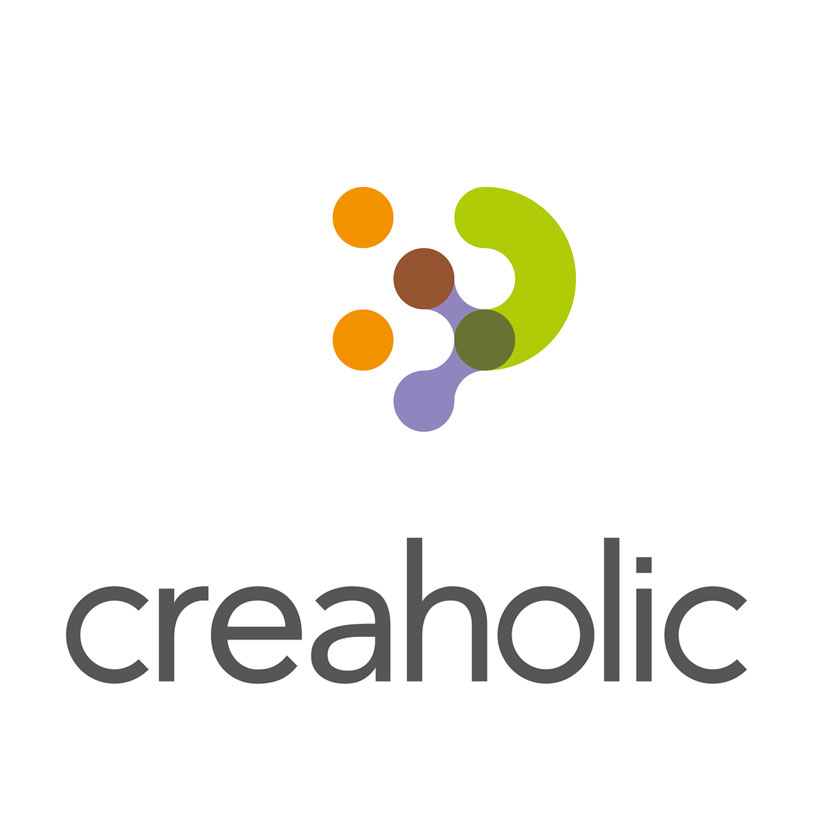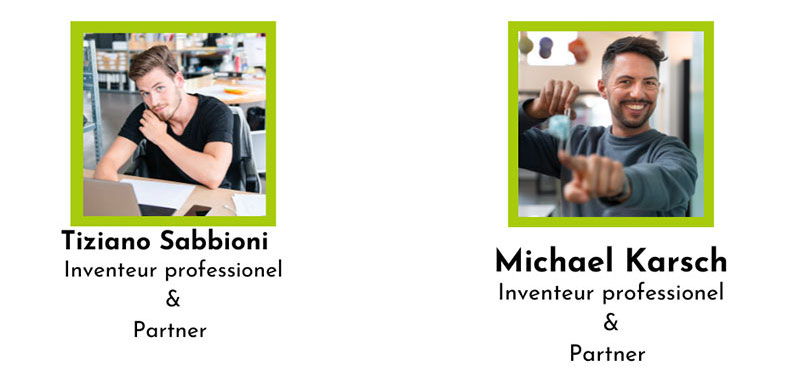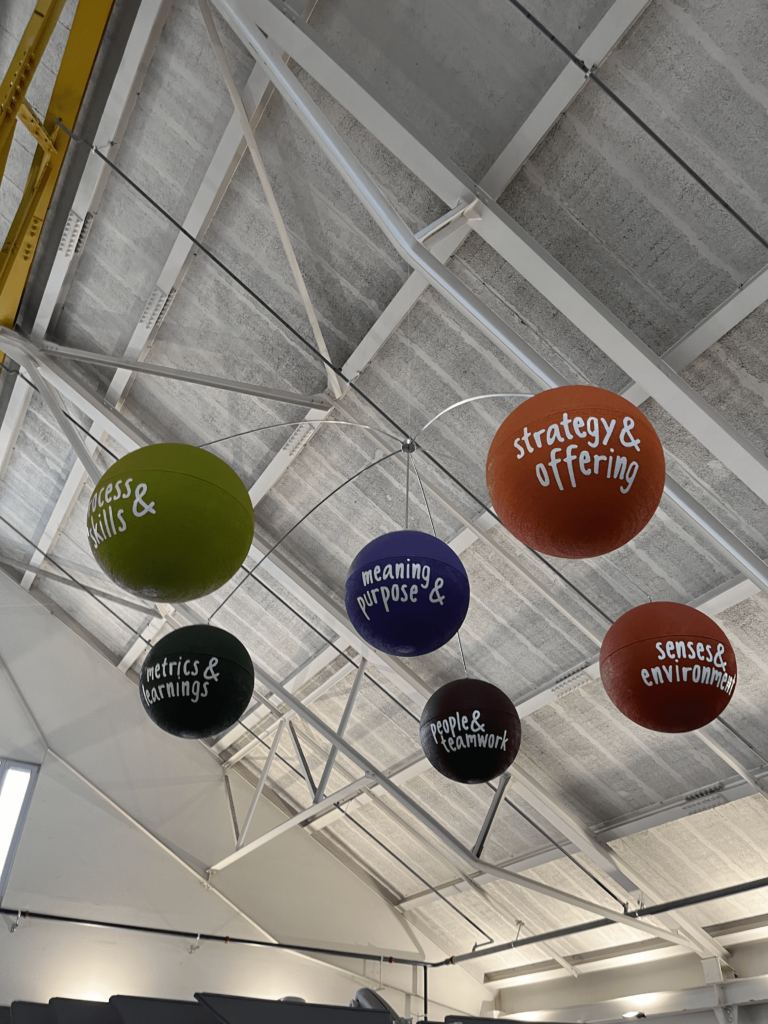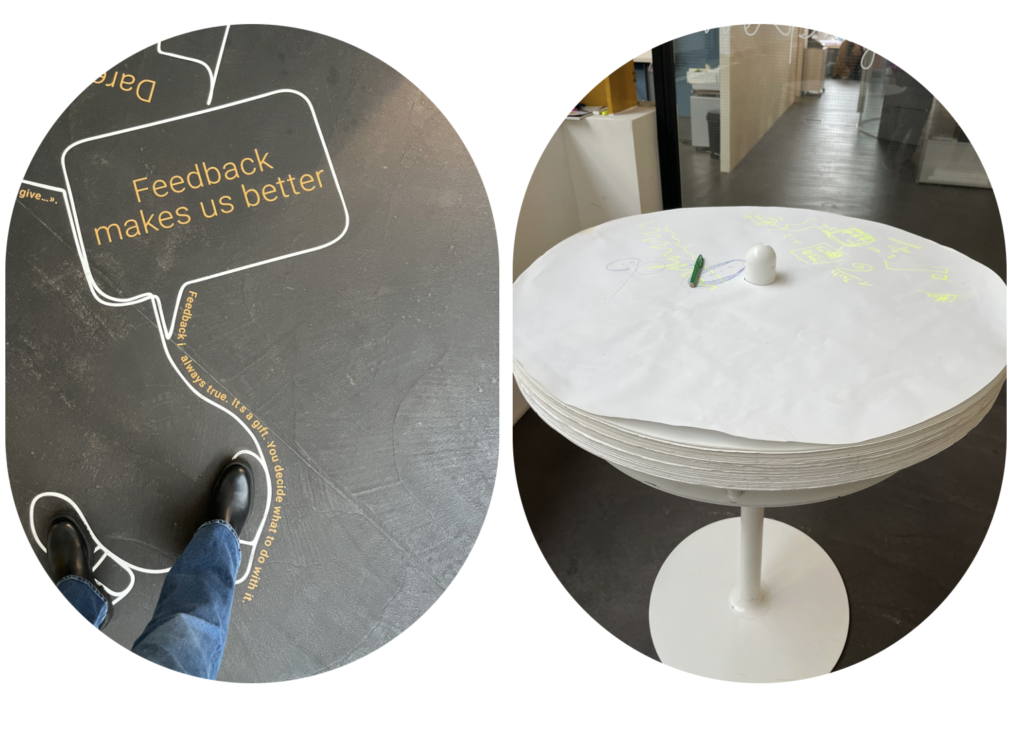
In this article, we will present the first Swiss company we met, in 3 steps: its managerial specificities, its way of dealing with crisis and its approach to organizational change!

Creaholic presents itself as an “innovation factory”. It’s a description that intrigued us from the start. Their concept is defined as follows: it’s not an engineering firm, not a consulting firm, not a design studio, not a manufactory… It’s a combination of all of these, led by an open-minded, free-spirited team. Their main objective? To invent innovative products and solutions.
On the ceiling, the 6 components of their innovation culture. (More info on these components here )


The culture of feedback is embedded into the company culture, as each Creaholicer has a peer with whom regular feedback is made.
Several writing tables are set up in the premises because “to encourage exchange and creativity, we need dedicated spaces” (Michi)
Through their role as innovation consultants, they are used to dealing with crises and to take the positives out of these. Indeed, companies call on them when they face a new problem, for which there is no solution. Creaholic’s role is to find an innovative solution.
Their approach to crisis is explained in their logo, broken down below: When faced with a “crisis”, there are :
Find Michi’s video explanation of the logo here.

Some of their innovations and their spin-off companies, act in favor of ecology: whether reducing energy consumption (projects “Gjosa”, “Joulia”) or acting for the preservation of the environment (project “Arboloom”).
Find their projects by clicking here .
When we meet with a company, in order to better understand each other, we offer them a definition of the crisis of meaning at work. Here it is.
According to Coralie Perez in the book Redonnez du sens au travail, in order for an employee to find meaning at work, 3 criteria must be met:
1 – Finding the social utility of one’s work
At Creaholic, consultants are free to choose the missions they wish to work on and they must be meaningful. Criterion 1) is therefore fulfilled.
2 – The individual’s capacity for action
Concerning the individual capacity for action, at Creaholic there is a metaphor used to define the autonomy and the responsibility of Creaholicers, that of the boat: It represents the company. If the decision I have to make could jeopardize the “hull” of the boat, i.e., jeopardize the existence of the company, then “I need to involve others to decide”, otherwise “I can make the decision on my own”. According to Tiziano, this decision-making culture allows them to be particularly responsive in times of crisis, since decisions can be decentralized.
Find the explanation of the boat metaphor in the video here.

3 – Being part of a principled system at the company level
Regarding the registration into a principled system, Creaholic is in the process of becoming B-Corp certified.
Just recently, Creaholic experienced a major change in its organization. Until now, Creaholic only had the structure to organize value-added functions (like project work or incubation) and support functions (like sales, IT, legal). In 2021, Creaholic decided to give more structure to its professional inventors, but in its own way: “each individual finds his or her “home” within a “cell” according to his or her dominant skill” says Michi . They have created 5 cells in all, each with a different theme (e.g. design, strategic thinking, sustainable development…). Indeed, it is important to know that each Creaholicer has several functions. For example, a Creaholicer can both work on innovation projects as an engineer and concurrently be in charge of an aspect of internal development.
“Managing partners” are the Creaholicers who are involved in the internal development of Creaholic, and they are the ones who drive organizational changes. They are therefore the ones who proposed the creation of the 5 “cells” in which all Creaholicers are placed. These cells function as think tanks rather than separators.
This change was welcomed because, according to Tiziano, one of Creaholic’s values is transparency. They believe in sharing information, so that Creaholicers can make decentralized decisions and understand the decisions that are made higher up.
Transparency within Creaholic is regularly worked on: “every 2 weeks, the managing partners gather all the employees to share the figures and results of the company, as well as the decisions taken and why” explains Tiziano
This regular and transparent communication is the key to a relationship of trust, which then allows for change to be understood and accepted.
In addition, the boat philosophy explained above helps to anchor a common culture regarding decision making. It allows everyone to drive change, knowing when it is necessary to involve others or not.
We hope you enjoyed this article! Thanks and see you soon!
lodysseemanageriale
Élodie & Dimitri
| Cookie | Duration | Description |
|---|---|---|
| cookielawinfo-checkbox-analytics | 11 months | This cookie is set by GDPR Cookie Consent plugin. The cookie is used to store the user consent for the cookies in the category "Analytics". |
| cookielawinfo-checkbox-functional | 11 months | The cookie is set by GDPR cookie consent to record the user consent for the cookies in the category "Functional". |
| cookielawinfo-checkbox-necessary | 11 months | This cookie is set by GDPR Cookie Consent plugin. The cookies is used to store the user consent for the cookies in the category "Necessary". |
| cookielawinfo-checkbox-others | 11 months | This cookie is set by GDPR Cookie Consent plugin. The cookie is used to store the user consent for the cookies in the category "Other. |
| cookielawinfo-checkbox-performance | 11 months | This cookie is set by GDPR Cookie Consent plugin. The cookie is used to store the user consent for the cookies in the category "Performance". |
| viewed_cookie_policy | 11 months | The cookie is set by the GDPR Cookie Consent plugin and is used to store whether or not user has consented to the use of cookies. It does not store any personal data. |